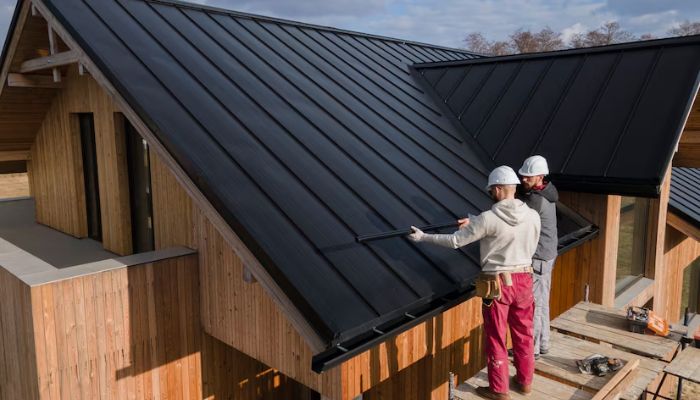The best siding for a home depends on your budget, climate, aesthetic preferences, and maintenance goals—but fiber cement, vinyl, wood, metal, and engineered wood are among the top options homeowners choose in 2025. Each type offers distinct advantages, whether you’re looking for durability, curb appeal, or energy efficiency. Choosing the right siding ensures long-term protection and value, making it one of the most important decisions in any home improvement project.
Let’s break down the most popular siding materials and evaluate them based on durability, weather resistance, cost, fire resistance, and other factors that matter most to homeowners.
1. Fiber Cement Siding
Fiber cement siding has become one of the most popular choices for modern homeowners. Made from a mix of cement, sand, and cellulose fibers, it offers the look of real wood without the high maintenance.
Pros:
-
Weather resistance: Highly resistant to extreme weather, moisture, and insects.
-
Fire resistance: Non-combustible material adds an extra layer of safety.
-
Low maintenance: Doesn’t rot or warp like wood.
-
Aesthetic variety: Can mimic wood, stucco, or masonry.
Cons:
-
Heavier and more expensive to install.
-
Requires painting every 10–15 years.
Long-term value: Excellent. It lasts 30+ years and boosts curb appeal, making it a solid return on investment.
2. Vinyl Siding
Vinyl siding is one of the most affordable and widely used siding options in the U.S. It’s made from durable PVC and comes in a wide variety of colors and textures.
Pros:
-
Cost-effective: One of the least expensive siding materials.
-
Low maintenance: No painting needed—just periodic cleaning.
-
Resistant to moisture and pests.
-
Many design and color options.
Cons:
-
Lower fire resistance compared to fiber cement or metal.
-
Can crack in extremely cold climates.
-
Fades over time in intense sun.
Long-term value: Good for budget-conscious homeowners, especially if you’re planning to sell within 10–15 years.
3. Wood Siding
Wood siding offers a timeless, natural look and is favored for its beauty and warmth. Common types include cedar, redwood, and pine.
Pros:
-
Unmatched curb appeal and natural texture.
-
Renewable and biodegradable.
-
Easy to customize or repaint.
Cons:
-
High maintenance (sealing, staining, or painting every few years).
-
Susceptible to rot, pests, and fire without treatment.
-
Expensive installation and upkeep.
Noise reduction is also limited unless additional insulation is used.
Long-term value: High in historical or high-end markets, but ongoing maintenance costs can add up over time.
4. Engineered Wood Siding
Engineered wood is a composite material that combines real wood fibers with resins for enhanced durability.
Pros:
-
Cheaper than real wood but with a similar look.
-
Treated for weather resistance and pest control.
-
Easier to install than fiber cement or traditional wood.
Cons:
-
Still requires periodic painting or staining.
-
Can swell or warp if not properly installed.
Return on investment: Strong in suburban and rural areas where wood aesthetics are popular but budgets are tighter.
5. Metal Siding (Steel and Aluminum)
Metal siding, especially steel and aluminum, is seeing a resurgence in modern and industrial-style homes.
Pros:
-
Excellent fire resistance.
-
Highly weather resistant and durable.
-
Virtually no maintenance required.
-
Recyclable and eco-friendly.
Cons:
-
More expensive up front.
-
Can dent easily (especially aluminum).
-
Limited color and texture options.
Noise reduction may require additional insulation layers to avoid echoing during rain or hail.
Long-term value: High, especially in fire-prone or extreme weather zones.
6. Stucco Siding
Common in Southwestern and Mediterranean-style homes, stucco is a cement-based siding that offers unique visual appeal.
Pros:
-
Excellent noise reduction due to thick layering.
-
Fire-resistant and energy-efficient.
-
Long lifespan with proper care.
Cons:
-
Prone to cracking in areas with soil shifting or heavy rainfall.
-
Requires skilled labor for proper application.
-
Repairs can be costly.
Return on investment: Depends on location. High in dry, warm climates; less ideal in wet or cold areas.
Factors to Consider When Choosing the Best Siding
Choosing siding isn’t just about looks. Here are key factors to weigh:
1. Climate Suitability
Your region’s weather should directly influence your decision. In areas with high humidity, weather resistance and mold prevention are top priorities. Fire-prone zones should focus on fire resistance, making fiber cement or metal better choices.
2. Maintenance Requirements
How much time and money are you willing to spend maintaining your siding? Vinyl and metal require less attention, while wood demands frequent care.
3. Energy Efficiency and Noise Reduction
Some siding types like stucco and fiber cement offer better noise reduction and insulation, reducing energy bills and creating a quieter interior.
4. Budget and Return on Investment
While upfront costs matter, think about long-term value and return on investment. Fiber cement and engineered wood strike a balance between cost and performance.
5. Aesthetic Goals
Finally, consider how the siding contributes to your home’s curb appeal. If you plan to sell, the right siding can increase resale value dramatically.
Final Thoughts
There’s no universal answer to what the best siding for a home is—it depends on your unique needs, location, and vision. Work with a licensed contractor to weigh pros and cons and find the ideal fit for your property.
With today’s options offering improved weather resistance, fire resistance, noise reduction, and long-term value, the right siding is more than just a pretty face—it’s a protective shell that improves your home’s performance and livability for decades.
If you’re planning a home exterior upgrade, take the time to explore materials, get multiple quotes, and consult a professional siding contractor for personalized advice. Your home deserves nothing less than the best.


Recent Comments